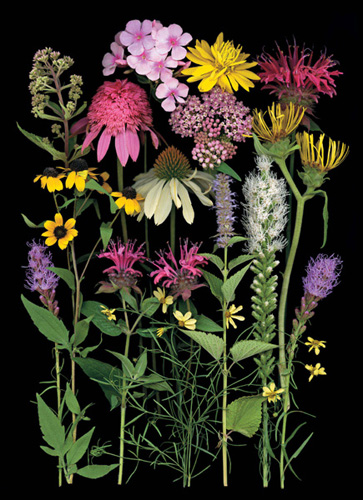
The best plants for butterflies not only entice them with flowers and nectar, but may offer leaves for larva to eat. Some colorful butterfly-attracting plants include: A Eupatorium purpureum; B Phlox paniculata ‘Nora Leigh’; C Rudbeckia laciniata var. ‘Hortensia Golden Glow’; D Monarda ‘Berry Red’; E Inula magnifica; F Liatris spicata; G Coreopsis lanceolata ‘Moonbeam’; H Monarda didyma ‘Raspberry Wine’; I Rudbeckia triloba; J Echinacea purpurea ‘Razzmatazz’; K Echinacea purpurea ‘The Swan’; L Asclepias incarnata; M Agastache foeniculum x rugosa ‘Blue Fortune’; N Liatris spicata ‘Alba’.


Although the fragrant flowers of the butterfly bush (Buddleia varieties) produce nectar for adults, their leaves offer nothing to caterpillars, unlike the native butterfly weed (Asclepias tuberosa), which feeds both the larvae and adults. Unfortunately, some of the the Buddleia species also pose a problem as a potentially invasive exotics in climates where their seeds have a long enough season to ripen and self-sow. All in all, it’s best to look for native, regional and local plant species if you’re in the market for orange, yellow, lavender, or lilac-colored fragrant flowers.
A true butterfly garden should have flowers with nectar, and also leaves to feed caterpillars. You can’t have butterflies without their larvae, and in a way, you can’t have birds without caterpillars. Birds need protein, especially when they are babies, and that means they need to find insects to eat.
As mentioned earlier, there are caterpillars that birds do not eat, however. These are species like the monarch that have evolved over the years to exclusively feed on plants in the genus Asclepias. The leaves contain toxins to which the caterpillars have become immune. Birds have learned that certain markings on colorful caterpillars indicate that they are unpalatable. The monarchs’ dependence on a specific food points out another reason to seek the host plant species that coevolved along with the insects.
Other relationships abound. Spicebush swallowtail caterpillars feed on Lindera benzoin (spicebush) and sassafras. The pipevine swallowtail is attracted to Aristolochia durior— the pipevine. Tiger swallowtails favor the waterside button-bush, Cephalanthus occidentalis. Many butterfly larvae and adults like the black swallowtail are attracted to members of the Umbelliferae—the carrot and parsley family—typified by umbrella-shaped inflorescences and ferny leaves.
Some butterflies do not care for pretty plants or nectar. They prefer to sip tree sap. Others feed on dung or carrion. There are fungus eaters, and ones that lick aphid honey-dew—the secretions of these and other plant lice. There are even butterflies that do not eat at all. Those species may live only for a day or two and survive on nutrient reserves from their larval stage.
Besides planting butterfly attractors, you can place pieces of overripe banana outdoors in a dish to gather them when they are in the neighborhood. Very often, the insects will be just as happy to find a spot of moist ground to “mud-puddle” in, and in the morning they also like to bask on a sun-struck rock.
Two-tailed swallowtail butterfly (Papilio multicaudata) on purple coneflower (Echinacea purpurea).
